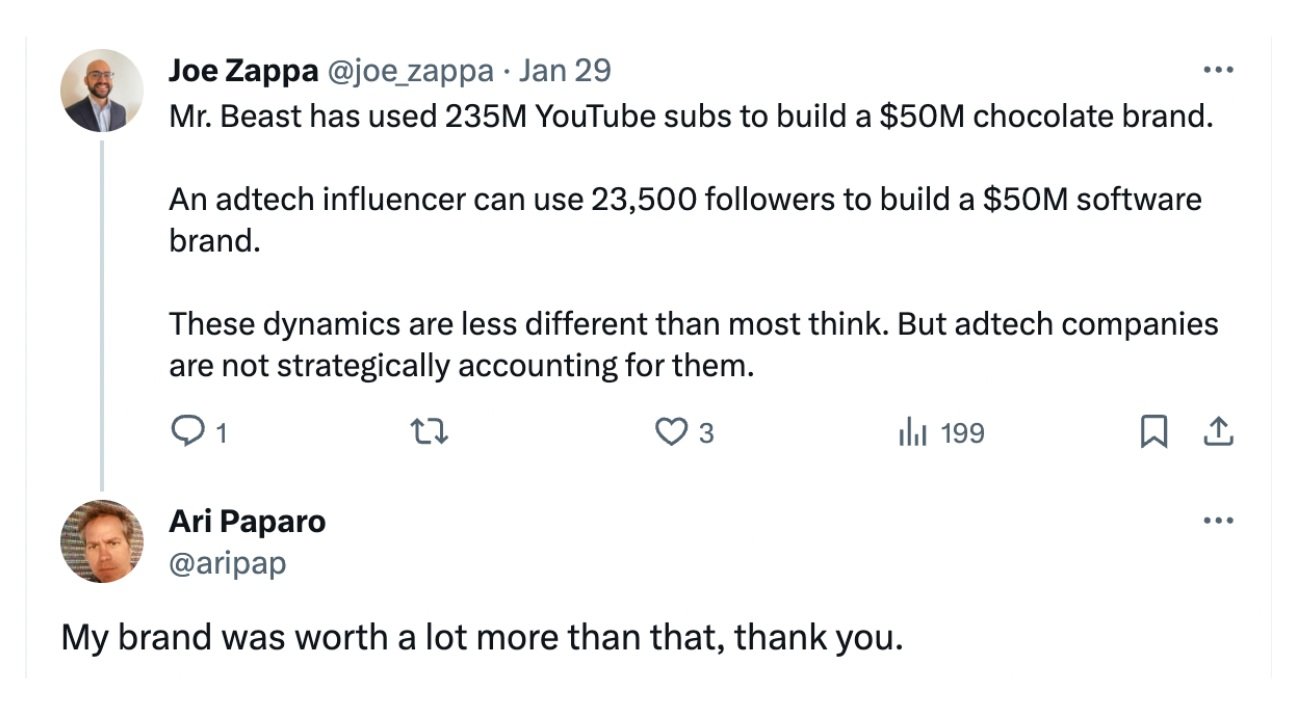Adtech Influencers Are Drastically Undervalued
MrBeast has used 235 million YouTube subscribers to build a $50M chocolate brand.
An adtech influencer can use 23,500 followers to build a $50M software brand.
Or a roughly $200 million brand.
These dynamics are less different than you think. But adtech companies are not strategically accounting for them.
The few adtech companies that recognize this opportunity can deliberately gain influence and steal market share in vulnerable, commoditized categories where most companies are quiet.
The B2C Influencer Economy Is Booming
Influencer marketing is a $21 billion industry. The creator economy, which refers not just to the creators who use their audiences to promote products (influencers) but all people who make money creating content via methods such as ads and subscriptions, is worth $250 billion.
These disproportionately young content creators — and the brands and tech companies that partner with and enable them — recognize the immense value in building online audiences. Creators are building their generation’s new media companies. And media companies have always enjoyed a synergistic relationship with the brands they promote.
Influencers Are for B2B, Too
But when most businesspeople (e.g. our fellow adtech business leaders and marketers) think about creators, they picture a 25-year-old female model promoting skincare products on Instagram. And that’s a mistakenly limited view of creators, who exist in every B2B sector.
Ari Paparo is an influencer. Matt Barash is an influencer. Dave Morgan is an influencer. All of these entrepreneurs, investors, and business leaders make content — via some mix of social channels, newsletters, podcasts, event appearances, and press opportunities — that grow their own brands and, by extension, the brands of any companies with which they are publicly associated.
This growth by association is the halo effect of influencer marketing, and yet I’d be willing to bet that less than 10% of adtech companies actively think about influencers as an integral part of their brand building and marketing programs.
Adtech Influencer Marketing Is an Undervalued Opportunity
I suspect the impact of influencer marketing in adtech is underappreciated for two reasons.
First, adtech companies generally overestimate the importance of product and underestimate the importance of their reputation and relationships. Talk to an adtech CEO about why they are successful, and they’ll tell you first about their product or the tangible results it drives. But ask their customers, and they’ll say, “They’re the smartest people in the industry. They go the extra mile for me. They treat me like an individual, not the same as every other advertiser or publisher.”
Yet many adtech companies spend nowhere near as much time and money building their reputation and relationships as they do on their product.
Second — and bear with me on the vibe-centric analysis here — adtech business leaders think the very idea of influencer marketing is cringe. CEOs view product, engineering, and sales as serious endeavors, whereas building an audience on Twitter, LinkedIn, and industry Slacks and WhatsApp groups — if it is a function they’ll invest in at all — is a task they’ll delegate to a marketing manager, if not an intern. I’ve spoken to a number of adtech CEOs who essentially say, “If I’m active on Twitter, will people think I’m not doing my actual job?”
The result is that most adtech companies have little to no audience to speak of. Their marketing boils down to a PR and events cadence that would’ve been appropriate before Facebook was invented.
Influence Allows You to Win in Commoditized Categories
The reason the failure to build an audience — to actively cultivate influence — is such a missed opportunity in adtech specifically is that many categories in this industry are commoditized. DSPs, SSPs, CDPs, data collaboration platforms (wink wink) — all are at pains to explain why their technology is unlike any other, why they drive the best performance and deliver the most comprehensive solutions, but when an external marketer like me talks to customers, they mostly say, “These products are similar. What makes this one the best is the people.”
Leveraging “people” as a competitive edge means investing in service, yes, but service is just the bottom of the people funnel. The top of the funnel is reputation or brand (the people who represent the company and build its reputation in the market), and the middle is relationships (which an online presence allows you to create at scale, beyond just shaking hands person by person at events).
The people factor is a big part of why Scope3 has taken off. It’s a big part of why Beeswax secured a favorable exit and is widely regarded as the premium brand in media buying technology. It’s why some companies have 90% name recognition among adtech insiders, whereas others, despite having customers that love them, linger in obscurity.
But the importance of influence doesn’t mean you need to sell a stake of your company or start sending fat checks to an adtech influencer (though I’m sure Ari would be happy to discuss the opportunity with you). It means you need to start recognizing the value of influence — and set out to cultivate it the way it is built in 2024. You need to think a little less like an engineer and a little more like MrBeast.

